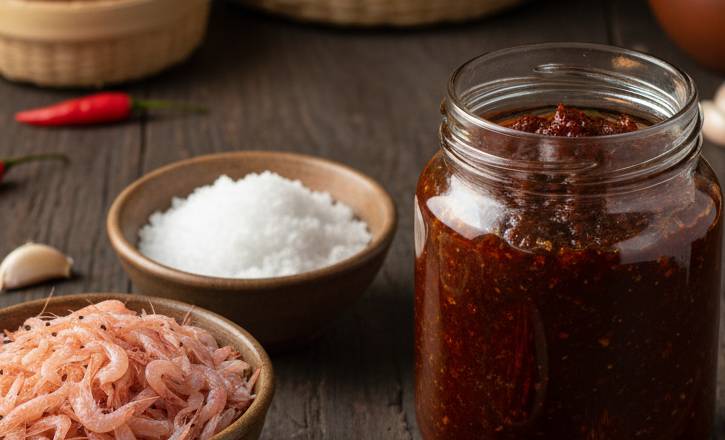
To the uninitiated, Bagoong might seem like a simple, pungent paste. To Filipinos, it is an essential pantry staple—an umami bomb that is the foundation of countless dishes and a perfect salty counterpoint to sour fruits like green mangoes. This beloved Filipino condiment, characterized by its intensely savory and “funky” flavor, is a study in traditional preservation. Understanding the core ingredients of Bagoong reveals the centuries-old fermentation process that transforms humble seafood into this complex, flavor-packed culinary treasure.
Step-by-Step Ingredients: The Core of Bagoong
Bagoong is a broad term for fermented savory condiments in the Philippines, but at its heart, the process relies on just two main ingredients: seafood and salt.
1. The Seafood Base: Fish or Krill
The first and most critical ingredient defines the type of Bagoong you have.
- For Bagoong Alamang (Shrimp Paste): This is arguably the most famous type. The base is tiny sea creatures called krill or minute shrimp (alamang in Tagalog). These small crustaceans are mixed with salt, resulting in a coarse, intensely flavored pink or mauve paste.
- For Bagoong Isda (Fish Paste): This version uses small, fresh fish. Common varieties include anchovies (dilis), bonnetmouths (terong), or round scads (galunggong). The result is usually a finer, darker, and more liquid paste. The clear, yellowish byproduct that rises to the top during its fermentation is filtered and bottled as Patis (Filipino fish sauce).
2. The Preservative: Pure Sea Salt
The second, non-negotiable ingredient is pure sea salt.
- Role in Fermentation: Salt is essential for preservation and flavor. It is mixed with the seafood base at a high ratio (typically 25% salt to 75% seafood by weight). The salt draws moisture out of the seafood and controls the bacteria, enabling the natural enzymes in the fish or shrimp to break down the proteins into amino acids—the source of Bagoong’s powerful umami flavor.
- The Process: The seafood and salt mixture is placed into large earthenware jars (tapayan) and left to ferment for a significant period, usually 30 to 90 days, or sometimes much longer to enhance flavor and depth.
Regional and Cooked Variations: The Flavor Enhancers
While the fermented seafood and salt form the raw foundation, the Bagoong most commonly used in American-Filipino kitchens is cooked and flavored—known as Bagoong Guisado or Sautéed Shrimp Paste.
- The Sauté (Gisa): To transform the raw, pungent paste into a sweeter, more balanced condiment, it is sautéed with the Filipino “flavor trinity”:
- Garlic
- Onion (often red onion)
- Tomatoes (for acidity and sweetness)
- The Sweet and Sour Balance: Essential for the cooked version, these ingredients mellow the intense saltiness:
- Brown Sugar: Adds necessary sweetness to balance the salt and fermentation.
- Vinegar: Adds tang and acidity, which cuts through the richness and helps preserve the cooked paste.
- Coloring: Sometimes, the raw Bagoong is dyed with Angkak (fermented red yeast rice) or food coloring to achieve a vibrant pink or red hue, though this does not affect the flavor.
Conclusion
Bagoong is a powerhouse condiment whose deliciousness stems from the simple, yet profound, interaction between small seafood (krill or fish) and salt during a slow fermentation process. Whether you prefer the raw, intensely savory flavor to accompany your green mango, or the complex, sweet-and-sour profile of the sautéed Bagoong Guisado as the base for dishes like Kare-Kare or Binagoongan, Bagoong remains a fundamental and delicious cornerstone of Filipino gastronomy. It is a testament to how preserving humble ingredients can yield a monumental flavor experience.
FAQ
Q: What is the difference between Bagoong Alamang and Bagoong Isda?
A: Bagoong Alamang is made from fermented minute shrimp or krill (alamang) and salt, resulting in a thick, pinkish paste. Bagoong Isda is made from fermented small fish (like anchovies or scads) and salt, which is typically darker, finer, and more liquid.
Q: How is Bagoong different from Patis?
A: Bagoong is the thick, solid paste of fermented seafood. Patis is the clear, yellowish liquid byproduct (fish sauce) that naturally separates and rises to the top during the Bagoong fermentation process. Patis is typically saltier and less pungent than Bagoong.
Q: Is Bagoong meant to be eaten raw?
A: Traditional, raw Bagoong (Alamang or Isda) is used as a dipping sauce, often paired with unripe green mangoes. However, most commercial Bagoong sold outside the Philippines has been sautéed (Ginisang Bagoong or Bagoong Guisado) with sugar, vinegar, garlic, and onions, making it safe and ready to eat as a condiment or ingredient.
Q: How should I store Bagoong?
A: Once opened, Bagoong (especially the sautéed Guisado version) should be stored in an airtight container in the refrigerator. Its high salt content means it has a long shelf life, but refrigeration helps maintain its freshness and flavor.
Q: My Bagoong is too salty. What can I do?
A: If you find the flavor too intense, you can slightly reduce the saltiness by adding ingredients like sugar (to balance the flavor), vinegar (for acidity), or a little bit of water or oil when you cook with it. Quick-rinsing raw Bagoong before sautéing can also remove some surface salt.